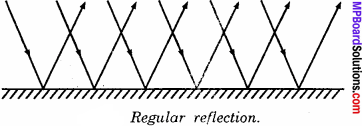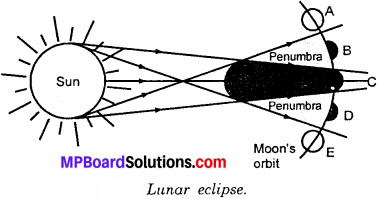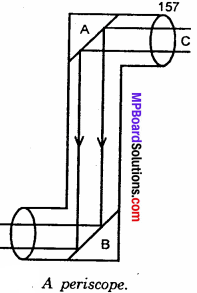MP Board Class 6th Science Solutions Chapter 11 Light, Shadows and Reflections
Light, Shadows and Reflections Textbook Exercises
Question 1.
Rearrange the boxes given below to make a sentence that helps us understand opaque objects?

Answer:
![]()
Question 2.
Classify the objects or materials given below as opaque, transparent or translucent and luminous or non -luminous? Air, water, a piece of rock, a sheet of aluminium, a mirror, a wooden board, a sheet of polythene, a CD, smoke, a sheet of plane glass, fog, a piece of red hot iron, an umbrella, a lighted fluorescent tube, a wall, a sheet of carbon paper, the flame of a gas burner, a sheet of cardboard, a lighted torch, a sheet of cellophane, a wire mesh, kerosene stove, sun, firefly, moon.
Answer:
Obaque objects:
A piece of rock, a sheet of aluminium, a mirror, a wooden board, a CD, a wall, a sheet of cardboard.
Transparent objects:
Air, water, sheet of plane glass.
Translucent objects:
A sheet of polythene, smoke, fog, a sheet of carbon paper, a sheet of cellophone.
Luminous objects:
A piece of red hot iron, a lighted fluorscent tube, the flame of a gas burner, a lighted torch, sun, firefly, kerosene stove.
Non – luminous Objects:
An umberela, a wire mesh, moon.
![]()
Question 3.
Can you think of creating a shape that would give a circular shadow if held in one way and a rectangular shadow if held in another way?
Answer:
Yes, we can think of creating a shape that would give a circular shadow if held in one way and a rectangular shadow of held in another way.

Question 4.
In a completely dark room, if you hold up a mirror in front of you, will you see a reflection of yourself in the mirror?
Answer:
No, in a completely dark room, we cannot see our right – left inverted image in the mirror, because there is no source of light.
Projects and Activities:
Activity 1.
Look around you and collect as many objects as you can an eraser, plastic scale, pen, pencil, notebook, single sheet of paper, tracing paper or a piece of cloth. Try to look at something far away, through each of these objects. Is light from a far away object able to travel to your eye, through any of the objects?
Record your observations in a table.
Answer:

Activity 2.
Describe an experiment which shows that light propagates in a straight line?
Answer:
In a homogeneous medium, light travels in a straight line path. This is called rectilinear propagation of light. This can be demonstrated with the help of three card – board pieces A, B and C with a fine hole at their centres. A candle or a bulb is placed on one side and the boards are arranged such that the holes are in straight lines as shown in figure. Looking from the other side, it is found that the fight from the candle is received only when the three holes are in a straight fine. If one of the card board pieces is displaced, the fight is no longer seen. This clearly demonstrates that the fight travels in a straight fine path.

Things to Think About:
Question 1.
Opaque objects cast shadows, isn’t it? Now, if we hold a transparent object in the Sun, do we see anything on the ground that gives us a hint that we are holding something in our hand?
Answer:
Yes, it gives us a fuzzy shadow on the ground, which gives us a hint that we are holding some thing in our hand.
Question 2.
We saw that changing colour of opaque objects does not change the colour of their shadows. What happens if we place an opaque object in coloured light? You can cover the face of a torch with a coloured transparent paper to do this. (Did you ever noticed the colours of evening shadows just as the Sun is setting?)
Answer:
Yes, the colour of shadow depends upon the colour of the objects. If we can change the colour of opaque objects, the same colour will be seen in shadow.
Light, Shadows and Reflections Additional Important Questions
Light, Shadows and Reflections Objective Type Questions
Question 1.
Choose the correct answer:
Question (i)
A pinhole camera forms an image of a building on its screen. Compared to the building, its image would be –
(а) Larger and inverted
(b) Larger and upright
(c) Smaller and inverted
(d) Smaller and upright.
Answer:
(c) Smaller and inverted
Question (ii)
The transparent object out of the following is –
(a) Water
(b) Moon
(c) Rubber sheet
(d) None of these
Answer:
(a) Water
Question (iii)
Which of the following objects allow more light to pass through –
(a) Translucent
(b) Opaque
(c) Transparent
(d) None of these.
Answer:
(a) Translucent
![]()
Question (iv)
The objects which do not allow the light to pass through them at all are called –
(a) Opaque
(b) Translucent
(c) Transparent
(d) None of these.
Answer:
(a) Opaque
Question (v)
In a room lighted by an electric bulb, it is found that the shadow of the ceiling fan hung in the centre is falling on a wall opposite to the door. What can you say about the position of the bulb –
(a) On the wall on your right as you enter the room.
(b) On the wall on your left as you enter the room.
(c) On the wall facing the door.
(d) On the wall on which the door is fixed.
Answer:
(b) On the wall on your left as you enter the room.
Question 2.
Fill in the blanks:
- Opaque objects cast shadow.
- The shadow is longest during and
- The totally dark portion of a shadow is called
- Surfaces act like mirrors.
- Solar eclipse occurs only on moon days.
- Lunar eclipse occurs only on moon days.
- A pin – hole camera is based on propagation of light.
- Surfaces act like mirrors.
Answer:
- Dark
- Sunset, sunrise
- Umbra
- Polished,
- New
- Full
- Straight
- Luminous.
![]()
Question 3.
Which of the following statements are true (T) or false (F):
- A fire fly is a hot source of fight.
- The sun is a natural source of fight.
- The tourch is a man – made source of fight.
- The partially dark portion of a shadow is called umbra.
- Formation of a sharp shadow of an object in sunlight is an evidence of the rectilinear propagation of fight.
- We do not see the shadow of the aeroplane flying high in the sky because the Sun is a point source of fight.
- Fluroscent tube is an extended source of light.
- If we keep 100 sheets of transparent paper one above the other, the heap of paper would behave as an opaque body.
- If we keep 100 sheets of translucent paper one above the other, the heap would behave as an opaque body.
- Regular reflection obeys only one law, namely, the angle of incidence is equal to the angle of reflection.
- Light does not interact with the living matter.
- Image formed in a convex mirror is shorter anti real. (xii) Concave mirror always forms a real image.
Answer:
- False
- True
- True
- False
- True
- False
- True
- True
- True
- False
- False
- True
- False.
Light, Shadows and Reflections Very Short Answer Type Questions.
Question 1.
Name any four man – made sources of light?
Answer:
The man – made sources of light are:
- An electric bulb
- A torch
- A candle
- A lamp.
Question 2.
Why do objects in a room become visible even if sunlight does not enter it?
Answer:
The objects in a room become visible during the day because of reflection of sunlight by the several non – luminous objects around us.
Question 3.
Give the names of four different sources of light.
Answer:
The four different sources of light are:
- Sun
- Stars
- Moon
- Firefly.
Question 4.
How does light travel from one point to the other?
Answer:
Light travel from one point to the other in straight line.
Question 5.
Why is the image formed in a pinhole camera inverted?
Answer:
The image formed in a pinhole camera is inverted because light travels in straight lines.
Question 6.
What is luminous objects?
Answer:
Objects like the sum that give out or emit light of their own are called luminous objects.
Question 7.
Does the flame of a gas stove emit light?
Answer:
Yes.
![]()
Question 8.
Give one example of living thing, which emits light?
Answer:
Firefly (Jugnu) is a living source of light.
Question 9.
Why translucent objects cast feeble shadow?
Answer:
Translucent objects cast feeble shadows because they allow the partial light to pass through them. So, every light or feeble shadow is formed behind the object.
Question 10.
State the conditions when annular solar eclipse occurs?
Answer:
An annular solar eclipse occurs when only the tip of the umbra of the moon falls on the earth.
Question 11.
Tube light is a cold source of light. Is this statement correct? If yes, then why?
Answer:
Yes, this statement is correct because tube light gives light only. It does not produce any heat. This is why tube light is called a cold source of light.
Question 12.
Classify the following into transparent, opaque and translucent objects: Wax, spectacles, a heap of salt, a stone, dense smoke, wood, skin, balloon, rubber, membrane of a table, blood and milk?
Answer:
Transparent objects:
Spectacles, membrane of a tabla.
Opaque objects:
Wax, wood, a heap of salt, a stone.
Translucent objects:
Dense smoke, skin, balloon, rubber, blood and milk.
Question 13.
What is the meaning of shadow?
Answer:
When any obstacte comes in the way of light then the portion on the screen where light does not reach is called shadow.
![]()
Question 14.
Why is the shadow of edges of a blade not clear?
Answer:
Because at the edges of the blade, the light is diffracted, i.e., bent slightly in the shadow region. Hence the edges of shadow of blade are not sharp.
Question 15.
Is the medium required for the propagation of light?
Answer:
No, the light can travel in vacuum.
Light, Shadows and Reflections Short Answer Type Questions
Question 1.
What is light?
Answer:
Light is the external physical reason which makes things visible. Light makes it possible to see the objects but light itself cannot be seen. When light falls on any body, it gets reflected and reaches our eyes and we feed the presence of that body. Light is also a form of energy. It can be converted to other form of energy. Light is propagated in the form of electromagnetic waves. Its wavelength is about 4000 A0 to 8000 A0. It can travel through vacuum with velocity of 3 x 108 m/see.
Question 2.
What do you mean by luminious and non – luminious bodies?
Answer:
The bodies which themselves are a source of light, and emit light they are called luminious. For examples, the sun, a burning candle, a light bulb, etc. Those bodies which do not emit light but are made visible by light falling from some luminious object on them are called non – luminious bodies. For examples, the earth, the moon, the table, etc.
![]()
Question 3.
Give the definitions of
- Transparent bodies
- Translucent bodies
- Opaque bodies.
Answer:
1. Transparent bodies are those through which light can pass freely and through which things can be distinctly seen. For example, air, water, glass, etc.
2. Translucent bodies are those which allow only a part of the light to pass through them and things cannot be seen distinctly. For example, butter-paper, ground glass, etc.
3. Opaque bodies are those which do not allow any light to pass through them and so we cannot through them. For example, stone, iron, wood, etc.
Question 4.
Give the differences between transparent and opaque objects.
Answer:
The differences between the transparent and opaque objects are:
Transparent Object:
- The light passes through these objects.
- They cast no shodow.
Opaque Object:
- The light cannot pass through these objects.
- They cast dark shadows.
Question 5.
State the differences between transluscent and opaque objects.
Answer:
Difference between transparent and transluscent materials:
Transparent Materials:
- The light pass through easily.
- Through it objects can. be seen clearly.
Transluscent Materials:
- It allows a part of light to pass through it.
- Through it objects can only be seen dimly.
![]()
Question 6.
How can you see a solar eclipse?
Answer: Solar eclipse can be seen by using a glass. There is another alternative method to see the sun. Take a piece of cardboard having a hole in the centre. This cardboard forms an image of sun on the wall. Thus the solar eclipse can be seen by this image safely.
Question 7.
Mention some of the uses of plane mirror.
Answer:
Uses of plane mirror are:
- In hair cutting saloons, shops and at home.
- For constructing periscope.
- For constructing kelidoscope.
![]()
Question 8.
State two properties each of umbra and penumbra.
Answer:
Properties of Umbra:
- The darkest part of the shadow is called umbra.
- The light in umbra does not reach from any source of light.
Properties of Penumbra:
- In this region light reaches from one part of the source.
- This region is not completely dark.
Question 9.
What is regular reflection?
Answer:
When the light falls on the smooth surface the scattered light rays move in a definite direction. This gives the clear image of the object. This. is called regular reflection.

Question 10.
State the difference between umbra and penumbra.
Answer:
Difference between umbra and penumbra:
Umbra:
The region of the space where the light does not reach from any source, is the darkest. This darkest part of the shadow is called umbra.
Penumbra:
The dark circular path is surrounded by a less dark portion. This shadow part is called penumbra.
Light, Shadows and Reflections Long Answer Type Question
Question 1.
Draw a diagram to show the position of the screen so that no umbra is formed on it if the source of light is bigger than the obstacle.
Answer:

Question 2.
Describe clearly the event of partial lunar eclipse and explain is cause.
Answer:
The ray diagram shows the various positions of the Moon as it passes through the penumbra and the umbra of the earth during a lunar eclipse. At position A, the moon is yet to enter the penumbra and it looks bright as usual. At position B, it has entered the penumbra. At this position, the moon looks pale, as if it has gone behind the clouds. After some time, a part of the moon enters the umbra. This part is then not visible from the earth, but the remaining part of the moon is still visible. This is called a partial lunar eclipse. Lunar eclipse, always takes place on full moon day but not on all full moon days.

Question 3.
How can you make a pin hole camera? Describe.
Answer:
Take two boxes so that one can slide into another with no gap in between them. Cut open one side of each box. On the opposite face of the larger box, make a small hole in the middle [Fig. (a)]. In the smaller box, cut out from the middle a square with a side of about 5 cm to 6 cm. Cover this open square in the box with tracing paper (translucent screen) [Fig. (b)]. Slide the smaller box inside the larger one with the hole, in such a way that the side with the tracing paper is inside [Fig. (c)]. Your pin hole camera is ready for use.

Holding the pin hole camera look through the open face of the smaller box.# You should use a piece of black cloth to cover your head and the pinhole camera. Now, try to look at some distant objects like a tree or a building through the pinhole camera. Make sure that the objects you wish to look at through your pinhole camera are in bright sun. shine. Move the smaller box forward or backward till you get a picture on the tracing paper pasted at the other end.
![]()
Question 4.
Describe the working of a its uses?
Answer:
A principle is an obtical instrument which is used to see the overhead objects. In a principls there are two mirror. A and B fixed at the two ends of a vertical tube whose reflecting surfaces are parallel and face each other.
Principle:
It is based on the principle of reflection of plane mirrors which are placed parallel. Light rays are coming through an object and entering from the apperture C. These rays strike on the mirror A at an angle of incidence 45° and is reflected along the axis of the tube striking the mirror at 45° again. This is then finally reflected parallel to their original path and reach is to the eyes of observer.
